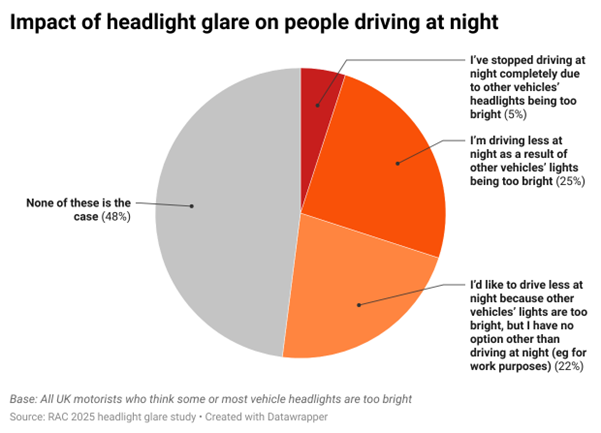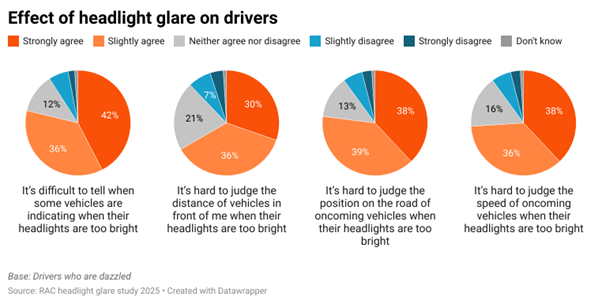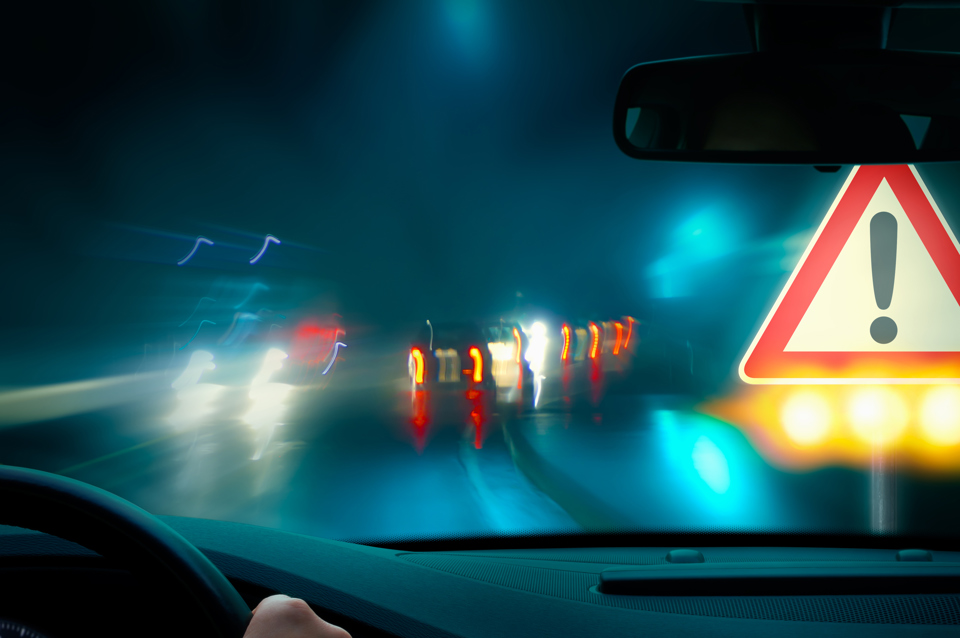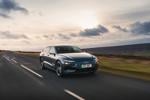More than a third (36%) believe most vehicle headlights can be too bright, with a further 59% saying some of them are, according to a major new study by the RAC.
What’s more, six-in-10 UK drivers (61%) who suffer from headlight glare say the problem has worsened in just 12 months, with only a quarter (26%) disagreeing.
The RAC study found that one-in-four drivers (25%) who find vehicle headlights too bright are driving less at night as a result, while one-in-five (22%) say they wish they could.
Three-quarters (75%) of those who drive less do so because intense headlights make the experience uncomfortable or more difficult.
A further 49% say it’s because they feel less safe, while one-in-20 drivers (5%) have stopped driving at night altogether.
Drivers aged under 35 are more likely to say most headlights are too bright (41%), as are those who drive conventional hatchbacks, estates and saloons.
Some 38% of this group said most are too bright, although three-in-10 (29%) of people who drive vehicles that sit higher on the road like SUVs say most are.
“The Government needs to take action – whether on the colour, intensity or angle of these glaring lights,” Baroness Dianne Hayter
Looking at motorists who still drive at night, almost a fifth (17%) say bright headlights leave them feeling tired and fatigued while driving, while 16% say they’ve suffered with headaches, migraines and/or eye pain.
Meanwhile, six-in-10 (59%) say dazzle makes driving more difficult and uncomfortable, a figure that rises to 65% for 65 to 74-year-olds and 67% for those aged 75 and over.
RAC senior policy officer, Rod Dennis, said: “What has gone from a mere frustration is now having a profound impact on people – whether that’s momentarily being blinded while driving or struggling to judge the speed or position of a vehicle ahead.
“The fact such a high proportion of people are also driving less at night – or wish they could – is remarkable and demonstrates the need for glare to be tackled.
“This does, however, need to be balanced with the potential road safety benefits afforded to people driving vehicles with brighter headlights.”

Headlight glare is a complex issue that may be caused by a variety of factors. These include the alignment of a vehicle’s headlights, changes in lighting technology – from halogen to bi-xenon and LED – and variations in vehicle height, as more drivers switch from conventional hatchbacks that sit lower on the road to higher-riding SUVs.
Following campaigning led by the RAC, Baroness Hayter and the College of Optometrists, the Government commissioned a project looking at the conditions most likely to lead to headlight glare, and to see what can be done to address them.
The project is due to report by the summer.

Of the 97% of drivers who told the RAC they are affected by glare in some form, eight-in-10 (79%) say they find it hard to tell when some vehicles are indicating, while 77% say it’s difficult to judge the position of oncoming vehicles on the road when their headlights are so bright.
Similar proportions struggle to judge the speed of these vehicles (74%) and how far away they are (67%).
These findings suggest dazzling headlights are having a profound impact on some motorists’ confidence behind the wheel.
Denise Voon, clinical adviser at the College of Optometrists, says that optometrists are hearing from patients more frequently that they’re having issues with night driving because of headlight glare from oncoming vehicles.
“Motorists must always wear their prescribed glasses or contact lens for driving, including at night, and we urge anyone experiencing issues with their vision while driving to contact their local optometrist for advice,” she said.
“However, more motorists are experiencing issues with their vision while driving at night earlier than we’d expect them to be impacted by age-related eye conditions, such as cataracts.
“We look forward to the findings from the Government’s headlight glare research project and hope this evidence enables the industry to find a solution that will reduce headlight glare and make driving at night safer for everyone.”
Drivers of vehicles like conventional hatchbacks and estates are more likely (56%) to say the problem lies with higher vehicles like SUVs, than drivers of higher vehicles themselves (28%).
However, drivers of higher vehicles are more likely (65%) to say they don’t think any particular type of vehicle is responsible, compared to 39% of those that drive ‘normal’ ride height vehicles.
Looking at the colour of headlights, 72% of glare sufferers associate the problem with whiter-coloured headlights (most likely to be LEDs or bi-xenon headlights), compared to just 3% who think the problem is caused by yellower-coloured ones (most likely to be halogen headlights).
One-in-10 (11%) say it’s both headlight colours that cause the problem while 15% aren’t sure.
Dennis said: “With the exception of potholes, few motoring topics seem to rouse as much interest among the nation’s drivers right now as bright headlights.
“It’s undisputable that public concern is increasing, but the reasons for glare and what can be done to reduce it aren’t nearly as clear.
“That’s why we’re pleased the Government heeded the calls of the RAC and our partner organisations on this issue and commissioned an independent project to look into it.
“We’re aware other European countries are now taking the matter seriously, too.”
The RAC research suggests that the difference in height of vehicles affects how drivers perceive glare, as does the colour of headlights on oncoming traffic.
It also appears to be more of a problem on unlit roads, where drivers’ vision is subjected to greater levels of contrast.
“We hope our findings prove to be valuable to both industry and Government in understanding the effects dazzling headlights are having on drivers,” said Dennis.
“At the same time, we’re pleased to be able to dispel some myths around the topic, such as the one that headlight glare is something that affects only older drivers.
“Interestingly, drivers under the age of 35 are more likely to say most vehicle headlights are too bright.”
Baroness Dianne Hayter added: “As this detailed study shows, virtually every driver experiences the problem of over-bright headlights, and many find the dazzle sufficiently problematic to stop or reduce their driving at night, with real social and other costs.
“The RAC has produced the evidence, now the Government needs to take action – whether on the colour, intensity or angle of these glaring lights.”
Official Government statistics show that since 2013, there has been an average of 280 collisions a year where dazzling headlights were a contributory factor.
Of these, six a year involved someone losing their life. However, this only includes those collisions where a police officer attending can be sure that headlight dazzle was a factor.





















Login to comment
Comments
No comments have been made yet.